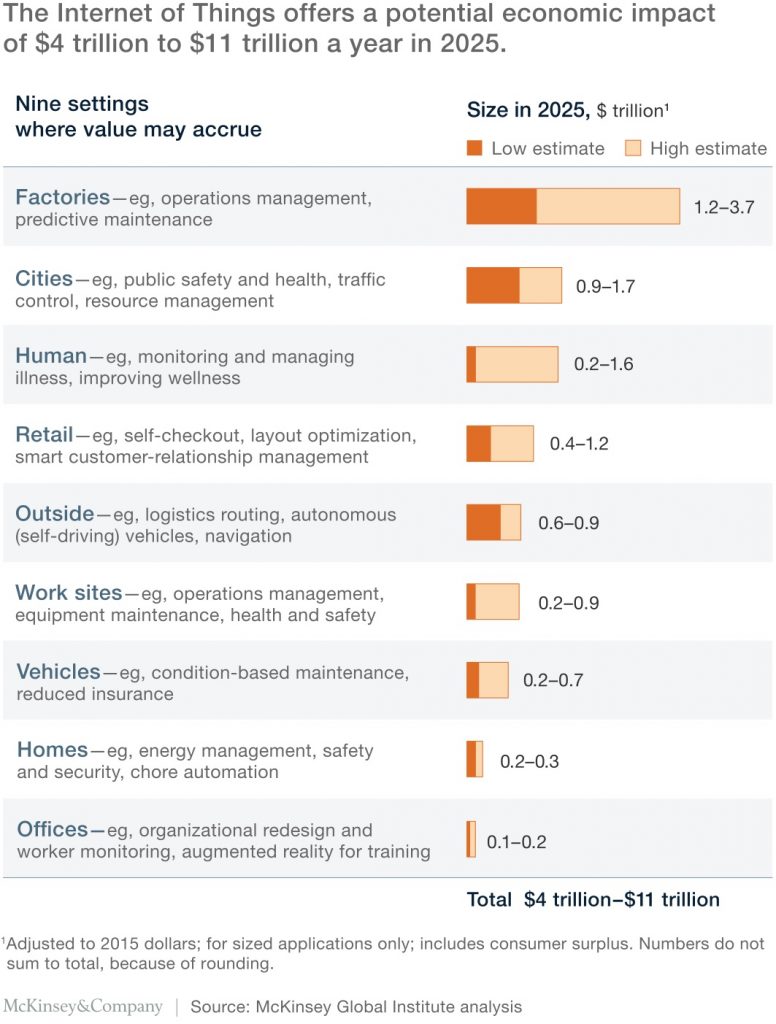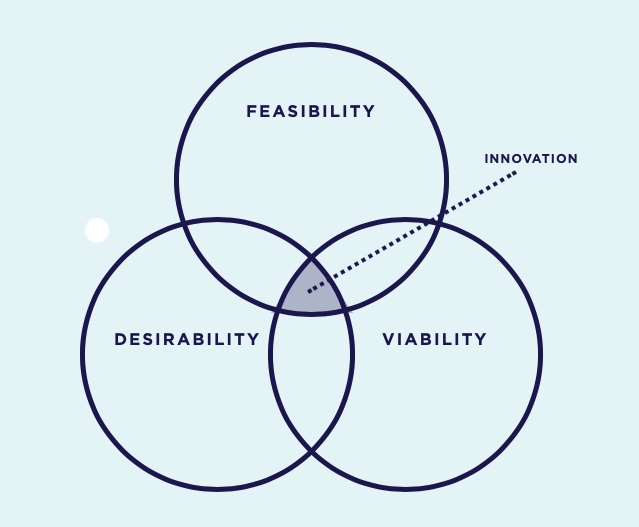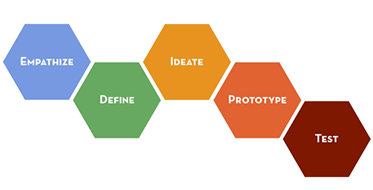A McKinsey analysis of over 150 use cases estimated that IoT could have an annual economic impact in the $3.9 trillion to $11.1 trillion range by 2025. At the top end, that’s a value equivalent to 11% of the global economy. We believe using design thinking when developing IoT solutions will help us reach financial targets.

It is not that difficult to envisage that degree of value-add given the continually evolving technical and strategic potential of IoT; there are new standards, components, platforms, protocols, etc. emerging almost daily. It is now possible to combine these options in seemingly endless ways, to address different use case requirements of connectivity, bandwidth, power consumption, user interaction, etc. to suit almost every potential application and user need out there.
There will, however, be several technical, regulatory and human resources challenges that will have to be addressed before we can extract the real value of IoT. But perhaps the biggest challenge will lie in the approach that IoT companies take to identifying user needs and developing solutions that represent real value.
Every technology cycle, from the dot com boom to the current AI gold rush, produces its own set of quirky, weird and downright pointless applications. And IoT is no different, with many products boasting connectivity features that may qualify them for a “smart” tag but offer no real benefits whatsoever. Every premier industry event like CES is followed by a slew of news roundups describing bewilderingly absurd “smart” solutions, from smart dental floss to $8,000 voice-activated toilets.
But we believe that IoT’s true potential and value will only emerge when the focus is squarely on leveraging the power of IoT to address what are known as wicked problems.
The concept of wicked problems was first defined by design theorist Horst Rittel in the context of social planning in the mid 1960s. It refers to complex issues, characterized by multiple interdependent variables and disparate perspectives, which seem impossible to solve. These problems do not necessarily lend themselves to traditional linear problem-solving processes and methodologies and require a new approach that can handle the inherent ambiguity and complexity of these issues. It was design theorist and academic Richard Buchanan who, in 1992, referenced design thinking as the innovation required to tackle wicked problems.
Notwithstanding smart litter boxes that can text and smart garbage cans that automate shopping lists, the focal point of IoT has to be on identifying and addressing intractable problems and design thinking is the approach that will enable the IoT industry to do just that.
Design thinking – A brief history
For many in the industry, design thinking is almost inextricably linked to Tim Brown and IDEO, and both played an important role in mainstreaming both the term and the practice. But as IDEO helpfully clarifies on its website, though they are often credited with inventing the term, design thinking has roots in a global conversation that has been unfolding for decades.
To understand how that conversation unfolded, we turn to Nigel Cross, Emeritus Professor of Design Studies at The Open University, UK, and his 2001 paper Designerly Ways Of Knowing: Design Discipline Versus Design Science. The paper traces the roots of what would eventually evolve into design thinking to the 1920s, and the first modern design movement. According to Cross, the aspiration was to “scientise” design and produce works of art and design that adhered to key scientific values such as objectivity and rationality.
These aspirations surfaced again, in the 1960s, but the focus had evolved considerably. If formerly the emphasis was on scientific design products, the design methods movement of the 60s focused on the scientific design process and design methodology emerged as a valid subject of inquiry. The decade was capped by cognitive scientist and Nobel Prize laureate Herbert Simon’s 1969 book, Sciences of the Artificial, which refers to techniques such as rapid prototyping and testing through observation that are part of the design thinking process today.
This “design science decade” laid the groundwork for experts from various fields to examine their own design processes and contribute ideas that would move the aspiration to scientise design along. IDEO came along in the early 90s with a design process, modeled on the work developed at the Stanford Design School, that even non-designers could wrap their head around, thus providing the impetus to take design thinking mainstream. By 2005, Stanford had launched its own course on design thinking. Today, there are several leading educational institutions offering design thinking courses and a whole range of non-design businesses that rely on design thinking to resolve some of their wickedest problems.
So, what is design thinking?
Let’s start with a slice of history again.
In the 80s, Bryan Lawson, professor at the School of Architecture of the University of Sheffield, United Kingdom, conducted an empirical study to understand how the approach to problem-solving varies between scientists and designers. The study revealed that scientists used problem-focused strategies as opposed to designers who employed solution-focused strategies. Scientists solve by analysis whereas designers solve by synthesis.
A problem-focused approach relies on identifying and defining all parameters of a problem in order to create a solution. Solution-focused thinking, on the other hand, starts with a goal, say an improved future result, rather than focusing only on resolving the problem.
Design thinking is a solution-focused methodology that enables the creative resolution of problems and creation of solutions, with the intent of an improved future result. It’s an approach that values analysis as well as synthesis. It is an integrated cognitive approach that combines divergent thinking, the art of creating choices, with convergent thinking, the science of making choices. Design thinking provides non-designers with elements from the designer’s toolkit that allows them to take a solution-focused approach to problem-solving.

IDEO’s definition of design thinking as a human-centered approach also includes what is often referred to as the three lenses of innovation; desirability, feasibility and viability. Human-centred design always begins by establishing desirability, defining what people want. The next stage is to establish if it is technically feasible to deliver what people want. And finally, even a desired and technically feasible solution must be commercially viable for a business. Design thinking, then, is a process that delivers innovative solutions that are optimally positioned at the overlap between desirability, feasibility and viability.
This framework should be the ideal starting point for product development in the IoT industry. Today, a lot of solutions seem to take desirability and viability for granted just because it is technically feasible to embed almost anything with connectivity. But is this the right approach to IoT innovation?
The 5-stage design thinking model
The design thinking process guide from the Hasso-Plattner Institute of Design at Stanford (d.school) prescribes a 5-stage model that progresses as follows:

EMPATHIZE: Empathy is a critical component of the human-centred design process as it rarely if ever begins with preconceived ideas, assumptions and hypotheses. This stage allows enterprise teams to better understand the people that they are designing for; understand their needs, values, belief systems and their lived experience. As the process guide puts it, the best solutions come out of the best insights into human behavior. Design thinking encourages practitioners to observe how people interact with their environment in the context of the design challenge at hand. Designers should also directly engage with end users, not in the form of a structured interview but as a loosely bounded conversation. Both these approaches can throw up insights that may not necessarily be captured by historical data or expert opinions.
DEFINE: This stage of more about defining the design challenge from the perspective of collected end user insights rather need defining a solution. The “define’ stage enables the synthesis of vast amounts of data, collected in the previous stage, into insights that can help focus the design challenge. At the end of this stage, it must be possible to articulate an actionable problem statement that will inform the rest of the process.
IDEATE: The purpose of ideation is not to hone in on a right idea but generate the broadest range of possible ideas that are relevant to the design challenge. Finding the right idea will happen in the user testing and feedback stage. In the meantime, use as many ideation techniques as possible to move beyond the obvious into the potentially innovative. Most important of all, defer judgement as evaluating ideas as they flow can curb imagination, creativity and intuition. At the end of the ideation process, define quality voting criteria to move multiple ideas into the prototyping stage.
PROTOTYPE: Build low-resolution (cheap and quick) prototypes as it means that more prospective ideas can be tested. Use these prototypes to elicit feedback from users and the team that can then be looped back into refining these solutions across multiple iterations. A productive prototype is one that communicates the concept of the proposed solution, stimulates conversation and allows for the quick and cheap failure of unworkable ideas.
TEST: Prototyping and testing often work as two halves of the same phase rather than as two distinct phases. In fact, the prototype design will have to reflect the key elements that must be tested and even how they will have to be tested. Testing need not necessarily focus only on users’ feedback to the presented prototype. In fact, this stage can sometimes generate new insights as people interact with the prototype. Rather than telling users how to use the prototype, allow them to interact freely and compare different prototypes.
And finally there is iterate. This is not so much a stage as a golden rule of design thinking. The point of design thinking is to create a repetitive learning loop that allows teams to refine and refocus ideas or even change directions entirely.
Of course, the Stanford model is not the only design thinking framework in circulation today. Those interested in more options can find an introductory compilation at 10 Models for Design Thinking. Though these frameworks may vary in nomenclature and process structure, some central design thinking concepts such as empathy and iteration remain common to most.
Is design thinking effective?
According to one source, only 24% of design thinking users measure the impact of their programs. Even a survey from Stanford’s d.school found that organizations struggled to determine ROI.
However, in an excellent article in the Harvard Business Review, Jeanne Liedtka, professor of business administration at the University of Virginia’s Darden School of Business, concludes, after a seven-year 50-project cross-sectoral qualitative study that “design thinking has the potential to do for innovation exactly what TQM did for manufacturing: unleash people’s full creative energies, win their commitment and radically improve processes.”
A more quantitative study by Forrester on The Total Economic Impact Of IBM’s Design Thinking Practice provides a litany of quantified benefits that includes the realization of $20.6 million in total value due to a design thinking-led reduction in design, development and maintenance costs.
But the limited availability of quantitative data has been offset by the steady stream of success stories of world-leading companies transforming elements of their business with design thinking.
Design thinking offers the framework that, at a fundamental level, will enable the IoT industry to reorient itself away from a “what can I connect next to the internet” mindset to a “where do users need help the most” approach. Its human-centric empathy-driven approach enables businesses to identify and understand potential contexts and problems from the perspective of the end-user rather than from the point of view of the possibilities afforded by technology. Companies can now use the three lenses of innovation to evaluate the practical, technical and commercial value of the solutions that they plan to deploy. And finally, the inclusive and iterative design process will ensure a much higher probability of success while enabling real value for customers.





